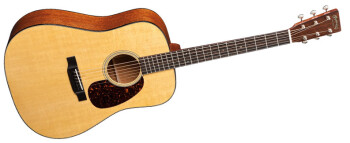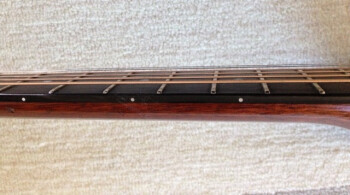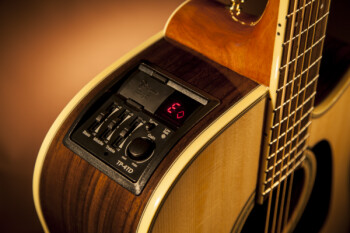Buying a steel-string acoustic guitar is an investment that you don’t want to go into lightly. Unless you plan to purchase a super-cheap entry-level model, you’re likely to spend a fair bit of coin for this instrument, and you'll presumably be playing it a lot, so you want to make an informed buying decision. It’s easy to be wowed when you try out a new guitar, and excitement can cloud your judgment. To help you evaluate whether a guitar is right for you, here are some factors to consider.
Tone, tone, tone
Obviously, you want an instrument that sounds good. If you’re guitar shopping in a music store, and find a model you like, try several of them, if possible, because every guitar is going to be a little different. You want to find the best one from the batch. Also, ask someone else to play it so you can hear what it sounds like from the front (which is different than from the player’s perspective). If you can, try playing it in a couple of different rooms, so that you’re not being influenced as much by the room acoustics — a guitar will sound less resonant in a room with carpeting, curtains or other baffling than in an empty one, where the sound can bounce around.
Find out what kind of wood the guitar is made of, and whether it’s solid or a laminate. Solid-wood guitars sound richer than those made of laminates, and improve with age, but they, are more expensive. There are some moderately priced guitars that have solid-wood tops with a laminated back and sides, which is a good compromise if you’re on a budget. The top wood will have the most impact on the tone.
|
The Martin D-18 features a dreadnaught body shape.
|
Sound is also impacted by the body type. Dreadnaught guitars are probably the most popular acoustic guitar size, and are bigger and louder than instruments like Martin 000 models or Taylor Grand Concert models. That said, some people find smaller body styles more comfortable to play, and some prefer their more balanced tone (not as bass-heavy as larger guitars). There are also jumbo acoustics, which are even larger than dreadnaughts. Doing a little research on body sizes before you shop will be time well spent.
Feel, feel, feel
Almost as important as how a guitar sounds is how it feels. The “action” (height of the strings from the fretboard) is a very important factor. If the action is too high, the guitar is going to be hard to play. If it’s too low you’ll notice buzzing on the frets, especially on the higher strings, up the neck. The action of an acoustic can be adjusted – that’s called a “setup”, but it’s not as easy to do as on an electric guitars, which have adjustable bridges. If you’re at a store, see if they’ll include a setup in the purchase price if the action is problematic.
|
The string height above the fretboard is called the “action, ” and if it’s too high, the guitar will be hard to play.
|
Find out what gauge strings are on the guitar, because if they’re different from what you’re used to using, it could change the feel when you restring it with your favorite gauge.
Tuned in
The intonation — the ability of the guitar to play in tune all over the neck — is a huge factor. Bad intonation will be frustrating and make it very hard to tune the guitar. Like with action, it’s much easier to adjust intonation on an electric than an acoustic, although it can be done. A quick test – compare the note of each string played at the 12th fret with the harmonic there — they should match.
Bear in mind that both action and intonation can be negatively impacted by a neck that’s out of adjustment. Look down the neck and see if it looks bowed. If it’s a new guitar, that’s not a particularly good sign. Consider whether the guitar has an adjustable truss rod – most do — because if it doesn’t, neck adjustments will be much more problematic.
Satisfactory condition
|
Cracks on a used guitar, although fixable, are a red flag that the instrument wasn’t properly cared for.
|
If you’re buying a used acoustic, you’ll need to check its condition. Look for cracks in the body or neck, as these could grow into a problem down the road. In a used guitar, cracks can indicate that the guitar hasn’t been well cared for and kept properly humidified. You also might see cracks in the neck or fretboard. If you do see cracks, beware, and ask to have the guitar checked out by a qualified guitar repair person before the deal is finalized. If that kills the deal, it’s probably for the better.
If there are dings in the body or neck, it means the guitar has probably been dropped or knocked int. These probably won’t affect the guitar structurally, but will harm resale value
Check the tuners out, as well. Do they feel smooth when you turn them, or do they turn unevenly? Sealed tuners typically are smoother, because no dust gets in their gears. If the tuners are hard to turn, they’re going to be a pain to use as long as you own the guitar. And since tuning is something you do constantly on an acoustic guitar, that might be a deal breaker, unless the guitar is incredible in all other ways, in which case it might make sense to buy it and replace the tuners.
Resale value
Somewhere down the road, it’s likely you’ll want to resell this guitar and move up to an even nicer one, so it’s important to think about the resale value. Condition aside, here are some factors that could make resale more difficult and less lucrative:
- The guitar is an off-brand. Well-known brands are always easier to sell.
- A non-standard finish. This isn’t usually an issue with acoustics, because the finish choices are pretty standard, but you never know.
- The guitar has been customized. Customized guitars can be a turn-off for future buyers. Guitars in original condition tend to be more valuable. You might like that giant rabbit someone painted on the back of your guitar, but potential buyers probably won’t.
Live-performance factors
|
The controls for the built-in electronics on a Takamine G50 series guitar. At the top of the image is the strap button on the heel of the neck.
|
Also consider: Will you be playing it onstage, now or in the future? If so, is there an electronics system built into the guitar, and what does it sound like? Listen to it plugged in, if possible. Some guitars have passive systems that require an external preamp, which would mean an additional purchase. Find out if that’s the case.
Another performance consideration: does the guitar have two strap buttons, or just the one on the end pin? If it’s the latter, you’ll have to use one of those straps that ties to the headstock, or get a second strap button installed. If you play standing up a lot, it’s something to think about.
In that case
Is a case included? If so, what kind? Unless it’s really well made, you probably want to shy away from thin and flimsy “gig bag” style cases, as these won’t give an acoustic a lot of protection. Hopefully, whoever is selling you the guitar, whether it’s a store or individual, will include a hard shell case or a heavily padded gig bag. Find out before buying, because it might mean an additional purchase otherwise.






